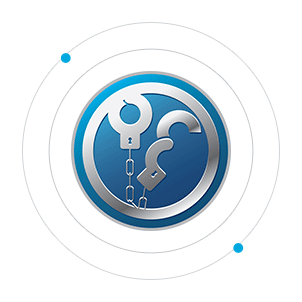Protection Against Ransomware Attacks: What They Are and How To Prevent Them [FULL GUIDE]
What is a Ransomware attack? In simple terms, it happens when criminals block your device remotely then ask you for money to unlock it. Let's take a look at the necessary protection against Ransomware and powerful internet security tips.
Internet threats are various, and even though Ransomware is experiencing a decline these days, it is still causing people several issues – so we will take a look at how to prevent Ransomware attacks. This is not a novel kind of cybercriminal, as the first instance of Ransomware was in the 1980s when attackers asked for payment to be sent via snail mail.
Scam Detectors Most Trusted Websites in Online Security
- Guard.io (100): Surf the web safely. Clean up your browser, remove maliscious extensions and check for privacy violations.
- Incogni.com (100): Delete your personal data from the internet and protect against scams and identity theft.
- ExpressVPN (100) Stay secure and anonymous online - Best VPN Out There
- IPVansish (100) Fast VPN to stay safe and secure online with multiple discount plans.
It is known as PC Cyborg or AIDS, and it encrypted the files in the C: directory of the victim's computer and asked the user to renew the license by sending $189 by mail to PC Cyborg Corp.
There certainly have been instances when something pop-up on your computer screen showing you that you have a ransomware infection. The great thing is that you can protect yourself from this threat, and we will provide you with all the necessary facts you should have in mind about the file-encrypting malware and the way it functions.
In our article, you will learn about Ransomware's different forms, the way you get it, where it comes from and who are its targets, as well as how to protect your computer against it. Let's start with a short description and show you how to stay safe online.
What is Ransomware?
Many people may not have even heard about it, but Ransomware is a kind of malware whose main aim is to encrypt files, making a person who possesses these files a victim, who will be later asked for a ransom. The attacker will require a ransom payment so that the victim can re-establish access to the data, and this will be possible only by getting the decryption key.
Criminals give the victim a short guide on paying a fee, which will lead to regaining the data, and the price of this fee can vary from a few hundred dollars to thousands depending on the attacker. The money has to be payable in Bitcoin so that cybercriminals can make use of it (here are a plethora of Bitcoin scams).

Recommended Read: Zero Day Vulnerability Email Scam
How Does Ransomware Work?
How can one become a victim? A ransomware attack can happen to anyone, sometimes without even noticing, but in most cases, people's curiosity makes these criminals able to access a computer.
The most frequently used way of getting into a person's computer is via phishing spam. These phishing scams contain various attachments, which you may get, including a file that is malware.
People are curious. It is in our human nature to explore and to desire to know everything. Not so tech-savvy people would download and open this file, whose main job is to possess the victim's computer. Malspam uses social engineering as the best way to trick people into opening the attachments or clicking on links that are sent to them, as they look like a trusted institution or a friend sends them.
It is worth mentioning that the Net is full of certain more destructive forms of Ransomware, such as NotPetya, which are designed to infect computers without even fooling users.
How else can we use protection against Ransomware?
“Your Computer Is Blocked. Pay Here”
Upon gaining access to a victim's computer, the malware starts encrypting the user's files. The most significant thing to know about it is that there is no other way to decrypt the files unless you have a mathematical key, typically known only by the attacker.
The victim usually gets a message informing him/her about the situation and telling him/her that the files will be decrypted if Bitcoin payment is provided to the attacker.
There were reports when the attacker claims to be authorities fighting against pornography or pirated software, which was found on the victim's computer not to report the attack.
Cybercriminals use social engineering, pretending to be the FBI to scare users into paying them a requested sum of money.
Another kind of Ransomware is called leakware or doxware. This case is when the criminal forces a victim to pay the ransom by informing him/her that the computer data will be published online. All in all, encryption ransomware is the most frequent type of cyber-criminal.
Who Is a Target For Ransomware Attacks?
Numerous people reading this would say – “Why will cybercriminals attack me? I am nobody, “and they are partially right. These attackers have a pattern according to which they choose, usually specific organizations as their targets. There were examples when attackers attacked universities due to not so great security teams and a user base that performs a lot of file sharing, making it easy prey for Ransomware.
Another target is some organizations that attackers believe will pay a ransom quickly. These are usually some government agencies or medical facilities that cannot function without having access to their files.
Furthermore, law firms and other organizations possess some sensitive data, and these are the most common targets of ransomware attacks. Some ransomware spreads across the Internet automatically, and everybody is a possible victim.
Protection Against Ransomware
People wonder how to prevent Ransomware. When people read about cybercriminal and believe that they may be easy prey, they would also like to know how they can use protection against Ransomware.
We suggest a few steps that can be taken so that people can prevent a ransomware attack. If you take the following steps, you will protect your computer from different sorts of attacks, not only Ransomware:
First, make sure the operating system of your device is patched and up-to-date.
When installing some computer programs, it is essential to know what kind of program it is and what it can be used.

It is necessary and mandatory if you are sensitive data on your computer to install antivirus software. These programs' main task is to detect whether malicious programs enter your computer and prevent its installation.
We suggest that you should make a priority of backing up your files frequently. Yes, you are right. This is not protection from a malware attack, but if you possess a backup of the files, you may not need to pay the ransom to regain it, and the attack will not be that significant.
Even though you have made the backup files, if you are attacked, you need to scan them for malware to make sure they are not infected, and this is because particular Ransomware is designed to look for backup files and attack them, too.
Ransomware Removal
Up to now, we have only spoken about the possibility of being attacked. However, what can you do if you are already a victim of Ransomware? Let's see. Your computer is infected with Ransomware, and you have no control over it anymore.
Here are the steps you are supposed to take to gain access to your machine:
- You will need to reboot your Windows to safe mode.
- The next step is to install antimalware software. It will help you find the ransomware program that took over your machine.
- You will need to scan the system so that the antimalware software can find the ransomware program.
- The last step is to restore the computer.
We find it very important to tell victims that this is the way to get access to your machine, but not to regain the files that have been taken by cybercriminals. Antimalware software is not designed to decrypt your lost files. They can be accessed only by possessing the key that the attacker holds.

Why Does Ransomware Exist?
The question to this answer is relatively easy – money. The whole world is spinning around money, and people do everything to get a fast and easy profit. As you may now see, a considerable amount of money is in Ransomware, and as the usage of the Internet has expanded, the ransomware market extended as well.
According to the data in 2017, people who were attacked by Ransomware lost $5 billion. This fact was due to the ransoms paid or the lost time in the process of recovering from attacks.
Like we already mentioned, some markets are especially attractive to attackers and more willing to pay the ransom. There is a statistic showing that 45 percent of ransomware attacks were performed on healthcare organizations, and Ransomware targeted almost 90 percent of financial institutions.
You need to bear in mind that your antimalware software will not always protect you from a Ransomware attack. Cybercriminals tend to continually develop new malware programs that are not still detected by antivirus programs. However, here is some good news for the end.
It has been noticed that the number of ransomware attacks declines. In comparison to 2017, when ransomware attacks were 60 percent of malware payloads; in 2020, it was only 5 percent.
Ransomware Attack: How To Report a Scammer
Let your family and friends know about the Ransomware Attack article on social media. You could also officially report criminals and suspicious activities to the FTC (Federal Trade Commission) using the link below:
How To Protect Yourself More
If you want to find out the most prevalent scams weekly, make sure to subscribe to the Scam Detector newsletter. You'll receive periodic emails – no spam whatsoever.
Meanwhile, educate yourself with some other fraud-related articles under this paragraph. Finally, use the Comments section below to expose other scammers:
- How to stop scam calls
- How to report phone scams
- NEW: How to Block Scam Likely Calls
- How to report scam emails.
- How to report a scam website
Verify a website below
Are you just about to make a purchase online? See if the website is legit with our validator:
vldtr®


TOP 4 MUST-WATCH FRAUD PREVENTION VIDEOS
1. Top 5 Amazon Scams in 2024 2. Top 5 PayPal Scams in 2024 3. How To Spot a Scam Email in 2024
- Latest Posts by Selma Hrynchuk
-
How To Stop Robocalls
- -
Taking Control of Your Data Privacy: Protecting Yourself in 2024
- -
The Urgency of Removing Personal Information from the Internet
- All Posts














This is a new one. I had a pop up for Privacy Guardian the would not go away. I googled it to locate where it came from. It generates from IOLA Technology Co. Which is affilated with System Mechanic. I had System Mechanic and switched to Norton some time ago. Maybe year and half. Privacy Guardian started up I contacted them. They want $179 to have their tech remove it. We had a long discussion about this, Why do I need to pay for your generated pop up Privacy Guardian. I did not subscribe to it. Don’t tell me you are trying to scam. I will make sure that this is reported. Their Agent I conversed with is suppose to be Kevin. We conversed in their chat room. I told them I would take my coomputer to Geek Squad and have them remove this. I am a member with them. Kevin was persistant that I needed to have their tech remove it that $179 is reduced from their normal price which was considereble high. Beware of the pop up that generated from IOLA, System Mechanic.